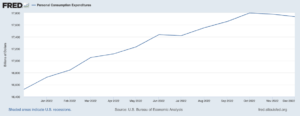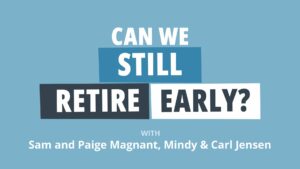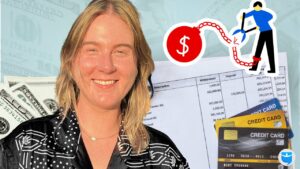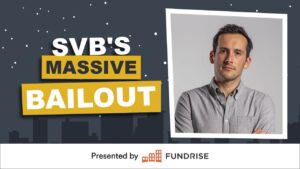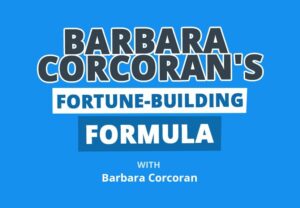
The housing market has dealt a tough hand to real estate investors as of late. Prices are staying the same, but mortgage rates are rising, rents have peaked, and so-called “easy” investments have been increasingly difficult to manage. The “lazy” investors who bought simple short-term rentals are now sitting with empty units, and BRRRRers that never adjusted their strategy are stuck with standard houses producing bleak returns. What’s the right move to make when investing is harder than ever before?
We wanted to know what’s REALLY happening in the housing market. So we brought on short-term rental expert Avery Carl, father of the BRRRR method David Greene, and luxury flipper James Dainard, to get their opinions on what’s working, what isn’t, and what investors should do now. Surprisingly, all these experts agree that ONE type of investing is the best way to go, and it’s such an obvious choice that you may miss it.
But, before this real estate investing strategy smackdown begins, we’ll get to know the current states of short-term rentals, flipping, and BRRRRing, plus which strategies are making money and which are falling flat. This is a new housing market; if you want to make it, you can’t play by the same rules.
Click here to listen on Apple Podcasts.
Listen to the Podcast Here
Read the Transcript Here
Dave:
Hey, what’s up, everyone? Welcome to On the Market. I’m your host, Dave Meyer, and today we are going to be doing a repeat of one our most popular shows of all time, a strategy showdown. We’re going to bring in an expert for some of the most popular real estate investing strategies and we’ll have them debate which strategy is the best for investing in 2023. For the fix-and-flip strategy, we have a On the Market regular, James Dayner joining us. James, how are you?
James:
I’m good, man. I’m chasing the sun. It was cloudy in Newport all weekend. I get to Seattle, and it’s raining.
Dave:
Well, isn’t that how those two places work?
James:
It’s not supposed to be cloudy in SoCal. It’s supposed to be palm trees and sunny.
Dave:
Oh, it’s the opposite. Sorry, I thought you were saying that it was cloudy in Seattle.
James:
No. Yeah, the clouds finally rolled in, but besides that, doing good.
Dave:
All right, good. And then, for representing short-term rentals, we have Avery Carl, who’s been on the show quite a few times. Avery, welcome back.
Avery:
Thank you so much for having me.
Dave:
We appreciate you being here. And representing the BRRRR strategy is David Greene from the BiggerPockets Real Estate Show. David, how’s it going?
David:
It’s good, man. BRRRR is cold, and that’s why the clouds are rolling into Seattle. I’ve sent them out there to block out James’s sun and cool things off a little bit.
Dave:
This is all part of David’s plan.
David:
He’s got hair, he can’t complain. Yeah, this is passive aggressiveness, the only time you’ll ever see it from me.
Dave:
Well, before we get into the actual debate, we are going to play a quick game to test, basically, your credentials for representing your respective strategies. So, I’m going to ask you each a question, it’s going to be particular to your expertise, to see if you know what’s really going on in the market right now. So, James, we’re going to start with you. As a flipper, I want to know how well you understand building costs and material costs right now. So, lumber, it’s been a lot in the news, how much it’s been up, it’s down. It’s up and down. What is the current cost of lumber? And lumber is typically measured by a cost per 1,000 board feet. So, do you know what it is?
James:
I know lumber has been going up and down a little bit of a roller coaster. And we actually just did our financial meetings on our new construction, so I know it’s up slightly. And I think it’s around like 450-ish a board in there. The weird thing is for flipping, it doesn’t matter as much because we use old lumber and we just kind of scab the stuff in, but for new construction it definitely matters.
Dave:
You just go find whatever you can find behind Home Depot that they throw out?
James:
Yeah. You keep as much as you can.
Dave:
All right. Well, you’re off by a little. It is actually around $580 per foot. That is obviously down a lot from the peak, which was back in 2021 where it was up. I think it was up at $1,600, which is insane because pre-pandemic, just for reference so everyone knows, it was about 200. So, it’s still almost triple where we were pre-pandemic, but down a lot from where we were just two years ago. So, you did pretty well, James. In the range.
Avery, we have to think of a tricky one for you.
Avery:
Oh, great.
Dave:
We want to know how many short-term listings there are on Airbnb? But not in the US, we want to know worldwide.
Avery:
Oh, I have absolutely no idea.
Dave:
That’s what I thought you would say. Do you know in the US?
Avery:
I don’t know in the US, no. It’s a lot of ground to cover there. And we’re in 20 markets, so I couldn’t tell you. You got me. What is it?
Dave:
Well, at your proliferation, I feel like you’ve represented a third of these, but there are about 1.4 million in the US, which just for everyone’s reference, that’s about 1% of all of the residential housing stock in the United States. But on a worldwide basis, it’s 6 million active listings with over 4 million hosts. And this has been growing like crazy over the last couple of years, which is something that we’ll definitely be talking about in a little bit.
David, I feel like you got an easy one. What is the current rate to refinance a property?
David:
Oh, I’m so glad you asked, Dave. I see that the bribe I sent in-
Dave:
Kailyn came up with it. She’s just throwing you softballs right here.
David:
That’s when it’s nice to be the host of the main podcast there. Everyone’s afraid of making me look dumb because the whole company would look dumb, right? After what you asked James, it’s like, “Dude, if he asked me the price per square foot of lumber, I’m done. No one will ever buy one of my books again.” I wouldn’t have even known how they price it. On a primary residence, it’s probably going to be somewhere around seven and a half, and on an investment property is probably low eights.
Dave:
Okay. Yeah. So, we did it for primary, as of July 20th, we’re recording this the following week, but it was about 7.3%. So, that’s where they’re coming in for refi. It’s not what you want to see. All right. Well, we’ll give you all a pass and we’ll allow you to move on to the next round of this debate where we can actually talk about what’s going on in the market. But first, we’re going to take a quick break.
Welcome back to On the Market. Today, we are going to be doing our strategy showdown. We have James Dayner representing fix-and-flip, Avery Carl representing short-term rentals, and David Greene representing the BRRRR strategy. Avery, I’d love to start with you because short-term rentals have really been in the news a lot. Can you just tell us a little bit about what’s going on on the ground with short-term rentals? And is all this hype about a big slowdown overblown or is it accurate?
Avery:
Well, it depends on your market because any part of real estate is going to be market specific rather than across the entire US. So, what’s going on in one major metro market is not what’s going on in maybe a smaller rural lake vacation market. So, it really depends a lot on the market what we’re actually seeing. So, I know in a lot of metro markets that have not had regulations, things have kind of changed because they were changing and making the value of primary homes too difficult for first-time home buyers to attain. So, we’ve seen a lot of change, especially in metro markets.
We’ve seen some changes in some of the bigger vacation markets now that a lot more sophisticated investors, sophisticated operators have moved into those types of markets. You can’t just buy your grandma’s vacation rental anymore and plop it on Airbnb and call it a day. You really do have to change your decor, make it really appealing, add some more amenities. You can’t just buy a brown cabin and throw it on Airbnb anymore. So, you got to make some effort now.
Dave:
And that’s a big change. Were you seeing people just buying regular cabins and throwing them on? And how do you think those people are doing right now?
Avery:
Oh, yeah. That’s what you could do when I first started buying these. So, you could buy just any old thing. One of my top producers for the first two or three years had blue laminate countertops and some peel and stick linoleum wood-look floors.
Dave:
Sounds nice.
Avery:
And we didn’t update it for the first few years because it was doing fine. But now, we’ve updated all of ours. You really do have to set yourself apart because the industry is changing. I would say I was an early adopter of that back in 2015, 2016 when we started and you could just buy whatever and put it on Airbnb and Vrbo and outperform what the previous management company had done because most management companies at that time were very archaic, weren’t really using Airbnb and Vrbo, or any really dynamic pricing tools. They’re like, “Well, here’s your summer price and here’s your winter price. And those were the two prices the whole year.”
Now, there’s a lot more sophisticated management companies, sophisticated self-manages that are optimizing pricing. They are adding crazy amenities. They’re doing a lot of things to really make their properties stand out. So, because the quality of the competition has risen since then, because more people are doing it, you also have to rise to meet that to set yourself apart.
Dave:
So, back when you started doing this a couple of years ago, it sounds like you could compete based on operational efficiency, basically, just being better than the other property managers, but now the actual amenities and quality of the property need to stand out. We asked you this question about short-term rentals, about how many of them there are, because supply has gone up a lot. And obviously, that means more competition for guests. Are you, in your properties, seeing a decline in bookings right now?
Avery:
So, across all of our eight properties in about four markets, we have seen a 3% decline from last year, but we’re still quite a bit ahead of 2019 and prior. So, it’s still an overall upward trend, but we have seen a small decline, not nearly as much as some news outlets would have you think, but we have seen just a slight decline. And we’ve still got a little bit of the year left to go in terms of getting books. We got some big holidays and stuff, so we may end up flat.
Dave:
Okay. Yeah, that doesn’t seem… I mean, 3%, also, that’s coming down off of really good years, right? That’s probably still significantly above pre-pandemic levels, I imagine?
Avery:
Right.
Dave:
Okay, cool. David, let’s move on to you. What’s happening in the BRRRR world?
David:
Well, the challenge right now for BRRRR is the same as what it is for traditional rentals or short-term rentals, cashflow. It’s very difficult with rates where they are, but prices staying high, to find any real estate that will cashflow when you first buy it. It used to just be, hey, we would analyze a lot of houses. If you think about when BiggerPockets really started to gain relevancy, and real estate investing in general was after the crash. So, 2010, ’11, ’12, we were all looking at houses and we’re analyzing. I remember my friend Aaron [inaudible 00:10:31] said they used to analyze a deal and if it had a 25% cash-on-cash return in A grade neighborhood of California or Florida or Texas, they’re just like, “Nope, that’s not enough.”
So, the method was just analyze as much as you can, find the highest cash-on-cash return and then that’s what you buy. And then over the years, more and more people hear about it from podcasts like this, and more and more money starts to move into real estate and we print a lot of money, so there’s more money to go out there and buy. And long story short, there are now more people buying houses than there are houses to buy and there’s a big need for housing. So, now rates go up and prices should have gone down, but we have such a discrepancy in supply and demand that they don’t. There’s still way too much demand for real estate than the supply can provide.
So, when you go to buy real estate, if it doesn’t cashflow, and you may have to wait a couple of years. Now, of course, some real estate will still cashflow. And if you manage it yourself, there’s opportunities you have. But this idea of passive income, just go on the MLS, find something, buy it, set it, and forget that’s gone, at least in today’s market. So, BRRRR is tough. If you’re trying to pull a large degree of your capital out of the deal, you’re still going to be left with about 25% equity in the deal. So, I don’t agree with the arguments that it’s dangerous because you’re over leveraged. It’s no different than if you went out there and put 25% down on a house. No one says that’s over leveraging, but when you leave 25% equity and on the refi it’s the same thing. It just doesn’t matter because it’s not going to cashflow.
So, the word on BRRRR is that BRRRR doesn’t work, but I see it like real estate investing traditionally doesn’t work. There has to be some kind of value add play to make investing work in today’s market.
Dave:
Well, isn’t that a big part of BRRRR is doing the value add?
David:
Yeah, and you will increase equity in the property, but you might not increase it enough to cashflow. So, we have traditionally looked at value add like, “Hey, fix up an ugly kitchen. Oh, the roof needs to be replaced, fix the roof. You can make it worth more.” And those things are value add, but you’re not going to bump rents by $1,000 in most cases by putting in a new kitchen or remodeling a master bathroom. So, it’s not enough to get the cashflow where it needs to be, though it may move the equity up that high.
So, I’m working on a framework now. It’s a book I’m going to be writing, and hopefully BP publishes, about the 10 ways you make money in real estate. And one of them is called forced cashflow. Now, when you’re looking to buy a property and add value to it, you need to see where can I add an ADU, where can I add an additional space that could be rented? Where can I split this house into two different parts or even three different parts so that different units can be rented? Because you have to find a way to generate enough revenue to cover that mortgage if you want it to cashflow in year one.
Dave:
Are there any markets you think, David, that are still possible to do, I guess I wouldn’t call it… See the performance of a BRRRR that you would’ve seen a couple of years ago
David:
Yeah, and at The One Brokerage we have clients that find these, and we talk about it amongst the company. So, when people come to us, we kind of steer them in those directions. There are, but they’re all going to be lower-price real estate. In the framework I’m creating that I mentioned earlier, you have what I call market appreciation cashflow and market appreciation equity, and that’s just this idea that not all real estate’s the same. Not every house or property is the same. The location it’s in matters a lot. Some areas it is reasonable to expect it will appreciate more than others. So, the markets where I see BRRRR working traditionally are not the same markets that you’re going to get big rent increases every year, big gains in value. Over a longer period of time, it will not perform as well, but you will get some of that short-term gratification of immediate cashflow right out the bat. A lot of that’s still in the southeast. I’m sure you were like, “David, are you going to give me a name?” Right?
Dave:
No, I-
David:
Mid-Georgia, South Georgia, you’re seeing some stuff there. Arkansas, you can still find traditional things. You see Ohio right now is gaining a lot of traction with the newer investor who’s just like, “I was given a calculator and I was told to find cashflow, and I’m going to find it.” They all go into those same markets where you can make it work. I just don’t like advising it because all the people I know that bought there, 100% of them that I’ve talked to have said, “Yeah, I wish I wouldn’t have done it. The rents aren’t going up. The value’s not going up. The tenant trashes the property, and now that killed two years of cashflow,” and they just can’t get off of that treadmill that made sense when they first got on.
Dave:
All right. James, I’m sure you were licking your lips when David said that you had to add value to make real estate work right now. He’s just giving you a layup for flipping. But tell us what’s going on with flipping.
James:
I actually wrote that down. Well, and I love this conversation because David just fully endorsed me. No, but I mean it’s no different than also what Avery said. You have to add value in whatever business that you’re in, short-term rentals, fix-and-flip, BRRRRs, development. You have to add that additional value to really rev-inize this, right? Avery says, you got to bring amenities in, add extra features in to get the rents up or to stay more full. Like David said, you have to create value, and that’s what we are seeing. And I don’t think that’s a shift. That’s just going back to normal. Because what has happened is there was too much money in the market, it was too easy and people were getting paid too much money for not having to operate well and now you have to operate well, which is how this business has worked since 2008.
It’s, you have to buy right, you have to execute the right plan. Fix-and-flip has been going actually fairly well for us the last six months. In the short term, when rates went sky-high, that did not feel good. We saw a lot of compression and now we’re getting more into normal selling, right? Things are selling within a couple percentage of list. The inventory in our local market has shrunk from 40 days, or homes sitting on market for over 40 days are now selling below 10. And so we’re seeing this absorption and what we are seeing is the lazy investor is moving out of the market, which has is created a lot of opportunity on heavy value add to where we can purchase these properties with extremely high margins.
And now, we’re doing less transactions, but the transactions that we’re doing are much better. They require more work, they require more planning, require more effort, but the return is worth it. Instead of having to do three houses, you can do it in one and feel fairly safe. And there’s a house I’m going to right after this meeting, we paid 670,000 for it. The house next door sold at 1.3 million. And now comps are trending up to 1.4 because that 1.3 was from the summer, but it’s a hard project, nobody wanted it. So, it’s all about if you want to sharpen your skills and execute well, you can find amazing buys out there. There’s not as many, but they are there.
Dave:
And how are your margins compared to how they’ve been over the last few years?
James:
So, our margins, the last couple of years when we’d do a walk-in expectation is we were targeting around a 30% cash-on-cash return in a six-month basis, and that’s factoring in for leverage on a construction loan. That equated out to about 13 to 15% cash-on-cash with no leverage. Now, we’re up to about 20 to 25% with no leverage or we’re up to about 45 to 50% cash-on-cash. Because the thing about large fix or a heavy value add, you’re financing in so much of the construction, your cash-on-cash return actually goes through the roof at that point because your leverage position’s better. And so, our returns have jumped at least 20, 30 points on the deals that we’re walking into.
Dave:
And do you think this is going to keep up? Are you optimistic for the fix-and-flip market for the next, let’s say, 12 months?
James:
I’m always optimistic about the fix-and-flip market. I mean, you can flip in any market. Like 2008 to 2010, the market was falling on us as we were flipping and we just had to pivot our business, adjust our underwriting, how we were doing things, how quickly we wanted in and out of deals. Going forward, I think construction is still really hard. The end user consumer is having problems getting properties renovated for a reasonable price. Investors that are newer are having problems keeping their hands wrapped around their construction costs as well. And so, I don’t see the inventory on the major fixer or heavy value add… There’s always going to be inventory right now because there’s also a limited segment of people that will actually take on these big projects.
And so as an investor, pivoting to what people don’t want to do is where you’re going to get the highest yield. So, yes, we plan on buying substantially more properties in the next 12 to 24 months. We bought two last week. I’m looking at more right now. It’s a good time to buy.
Dave:
Yeah, it’s interesting. I think we were talking about this recently, James, but I saw some data that was showing that despite the fact that there hasn’t really been a nationwide correction, I mean very modest one, that if you look at property classes, the fix-and-flip, sort of the class C, class D properties that need a lot of work are falling, but the stabilized assets, class A properties are actually going up right now. So, that just creates a bigger margin opportunity for value add and it seems like that would be beneficial across the board for any of these three strategies.
James:
Yeah, and it’s a liquidity crunch. For the end buyer, everything’s more expensive. People’s capital and their money is just getting eroded, and so they can’t buy a property and come up with the money with their high new interest rate and come up with the money or nor do they want to separate with that money because they want to keep it on hand. And so that’s why there’s such a huge gap now between fixers and stabilized houses, and those gaps are where we make the money.
Dave:
That’s a great point. I did want to ask you about that. So, Avery, I’ll ask you. It does seem like this idea here, that value add totally makes sense to me that this great approach across strategies right now, but that’s a lot more capital intensive. You’re talking about adding furnishings, adding amenities. Are you seeing a different type of investor moving towards short-term rentals right now or perhaps a reduction in demand from investors for short-term rental properties?
Avery:
Well, a few different things. So, in short-term rental, where we can add… Not necessarily adding value like appraisal value, but adding income you can do for significantly cheaper than in other asset classes. So, for example, when you’re adding amenities, so one of our agents in Panama City right now has added a snow cone bar to her property to make it really attractive. So, that’s not very expensive, but people like me who have little kids will say, “Oh man, my daughter will love that. I’m definitely booking that.”
Dave:
Who makes the snow cones though?
Avery:
It’s a maker. It’s not a person.
Dave:
Oh, it’s like a machine? Okay. I thought someone was making a snow cone. Yeah, I got you.
Avery:
That would be pretty expensive to have a person go… But yeah, so people are doing things like snow cone bars. I’ve seen biscuit bars. I’ve seen people adding putt-putt courses. Just little things to make the property more attractive. Or mural walls, that’s a big one too. Maybe that’s 1,500, 2,000 bucks, to make the property stand out. So, it’s not necessarily about adding appraisal value, although that is important as well. There are other ways you can do it in terms of just adding income.
Now, in terms of who’s buying these? I think we’ve definitely seen a reduction in the number of investors, we’ve seen the volume go down. Just because two or three years ago when everything was 2-3% interest, there were a lot of people getting into the game that, I hate to say that didn’t need to be there, but they weren’t looking at it as the business that it is. It’s not just buying a really fun beach house and throwing it up on the rental services and then just saying, “Hey, friends, look at my cool beach house. I’m so cool.” It is a business. You have to analyze, you have to know, you have to be in there tweaking your listings every day. “Well, you know what? I’m six weeks out and I don’t have September bookings yet. I need to be messing with my pricing. I need to maybe change some photos and things like that.”
So, we’ve seen a lot of those more amateur folks who weren’t really looking at it as a true business to run dropping out, which is good because those are the ones that are getting in trouble now with they thought they could just throw their phone in the trash and sit on the couch the rest of their life, and it’s just going to make money on Airbnb, and that’s just not the way it is. You do have to truly run it like a business, get in there every day and look at things and change things, and analyze really well and pay attention to where the money’s coming from, and what is attractive about your property and what you can add to it to increase that income.
Dave:
So, does the absence or withdrawal of some of these less sophisticated investors pose an opportunity for experienced investors like you, or are you sort of waiting to see how the dust settles with the economy? What are you thinking?
Avery:
It definitely does present an opportunity because there’s just less competition. But like David was mentioning, there is a little bit of a stalemate when it comes to the supply and demand. So, there’s still not enough supply for people to really be getting these huge, huge discounts yet because there’s just not enough. So, it’s keeping the prices pretty high, but what we are seeing is those people who bought really high, who are like, “Man, this isn’t for me. I thought I was just going to be able to set it and forget it.” Those people looking to get out, they are a little bit more motivated than someone who’s just ready to move on. So, there are definitely opportunities to find, I wouldn’t call them distressed sellers yet, but those who are pretty motivated to get their properties gone, you just have to be willing to make a certain volume of offers. Not every single seller is going to be at that point yet.
A lot of them are still living in the past. They’re not up here with us yet about where values are. They’re still wanting that 100 offers on every property thing they saw what their neighbors did two years ago. And now, they realize they kind of missed the boat and they’re like, “Oh, let me list it and see.” So, it’s just kind of a weird stalemate in the market because of that supply and demand problem.
Dave:
Generally speaking, are there good opportunities for you right now or is it tough to find things to even bid on?
Avery:
There’s absolutely opportunities. There are more than there were two years ago, there are less than there were five years ago. But buying a blank-slate property in the right location, maybe with the right view and adding the decor and amenities to it to make it one of those really standout properties is the strategy at the moment. I mean, just like any other asset class, the value add is always going to be something that’s really important in terms of being able to make numbers work. So, whether that’s finding something where you can add an extra bedroom, which will create extra income, or doing mural walls, things like that, themed properties, there’s a number of ways you can go about it that’s a little more flexible in short-term rental than just that, what can I add to the equity number?
So, it’s flexible. And I would say that buying the right property in the right location that’s more of a blank slate than something that’s already finished in terms of decor is a good way to go. I saw… I can’t remember who put it out, one of the data companies, maybe it was AirDNA. It’s several hundred thousand dollars cheaper to buy a property that doesn’t have a pool and put it in to add that extra income than to buy a property that already has the pool, because most people don’t want to do that work. So, it’s just a matter of finding those opportunities on the property that’s in the good location, or that has the good view, or X, Y, or Z, to add those amenities or income-producing factors than just going and finding the best property available.
Dave:
That’s great advice, David. With BRRRR, it’s often touted as a great way to scale quickly because you can reuse your money, which is true. Do you have any recommendations for people? Given what you’re saying about the right strategy being value add that is more capital intensive, do you have any advice for people who still want to do the BRRRR strategy but might not know how to come up with the cash or how to finance something like that?
David:
Well, it’ll allow you to scale quickly if there’s something to buy. When the book was written, there was opportunities everywhere.
Dave:
You’re going to have to release an updated version of the book.
David:
Yeah, exactly. You can have all the capital in the world, you can’t find anywhere to put it. That’s really the problem most people have is we print all this cash, it’s found its way into the hands of the right people that are good at managing money and they’re like, “What do I do with it?” We can’t buy bonds. You can’t really invest in stocks because you’re probably not making as much as inflation. Real estate’s the only place for that money to go. So, it all floods into real estate. “There’s no cashflow. What do I do? I guess I could better go buy a short-term rental because you can get more revenue there.” So, that market gets saturated. That’s really what the problem is.
For someone who doesn’t have a lot of capital, I don’t know that real estate is what I would tell them they should go and do. It doesn’t mean they shouldn’t buy real estate, but I don’t think that that’s where the meat and potatoes of their efforts should be at. You should be house hacking a house every year. Put 3.5% down on the first one, put 5% down on the next one. If you’re buying a house every year it’s still a pretty big win if you buy it in the right market-
Dave:
Absolutely.
David:
… and you manage it yourself. If you don’t have any cash, this is an unpopular opinion, I get called a heretic for saying this, I still say it, you need to figure out why you don’t have money. Some people could survive and thrive in this market, but they don’t like hard work, so they look at real estate as their way around hard work. Capitalism is capitalism wherever you go, and the market’s going to reward the people who bring the most value to it. If you don’t have any cash and you’re saying, “Well, I want to fix my cashflow by making a lot of money in real estate,” it’s an unforgiving place at this stage in the market to try to build capital.
It used to be, man, you could get everything wrong and the house would be worth twice what you paid for in six years. It was a very forgiving market if you didn’t have a lot of capital. I don’t think that’s the same space we’re in right now. So, I wrote a book about that, it’s coming out in October. It’s called Pillars of Wealth, and it basically just says, “Hey, there’s a three-prong approach to becoming a millionaire. Offense, defense and investing.” We only talk about investing on this podcast, but offense and defense are just as important. You have to live under your means. You have to live on a budget, you have to save more money every month than what comes in, and you have to focus on the art of making money.
Look at the four of us that are on this thing. Every single person here does more than just invest in real estate. None of us are living off just cash flows. We are actively running businesses, like James has got his hands in 17 different things that he’s doing to make money in real estate, and then one of the places he puts that money is real estate that he goes to own. I think if the people who are teaching you are doing it, it would be disingenuous to be telling the listeners, “Oh yeah, you could just buy real estate. Just use the BRRRR method. You don’t need money.” That’s been thrown around a lot. Occasionally, a deal falls in your lap or you find one where, yeah, the person’s willing to sell it to you with zero money down on seller financing and all the stars align. But in general, you have to be thinking about work today and not living a lavish lifestyle and investing the difference into real estate that will appreciate over the long term and having delayed gratification. Did I just bum everyone out?
Dave:
No, I just think you’re losing this debate. We’re going to start debating. No, but I think it’s a great point. I mean it is a tough market, especially for value add if you don’t have a lot of capital. It’s definitely a more capital-intensive thing. But quickly, David, then I do want to start talking about some other things, but is there anyone who BRRRR is right for right now? Who would you recommend it for?
David:
Okay, I forgot we were having a debate. That’s the problem because I started just preaching to the masses, but financial responsibility.
Dave:
It’s okay. We’re doing some background information and we’re going to move to the debate, so I want to give you another chance on this one.
David:
Yeah, here’s where BRRRR will work well in today’s market. It forces you to buy right and to add value. If you want to make a BRRRR work, you have to buy it below market value or you have to add value to it or some combination of the two, which is what works in today’s market. So, you may not be able to get the home run BRRRR, 100% of your equity out in six months and then immediately go just place it again. The way that we’ve taught the model has been ideal. That might not work very well in today’s market. However, it helps you avoid the turnkey trap that you get sucked into where you pay too much for a house that doesn’t need any work at all. And then you get mad at real estate because it didn’t work out, like Avery was saying.
Now, there’s a little bit of elbow grease you need to put into this thing. The BRRRR method forces you to do that. So, the people that I think that the BRRRR will work best for would be some form of house hacking combined with BRRRR. You’re going to go out there by the biggest ugliest house that you could possibly find for the lowest money down in the best neighborhood you can get your hands on. And over the course of a year or two, you’re going to fix that house up, you’re going to convert the basement, you’re going to convert the garage, you’re going to build an ADU. You’re going to do something to make that property worth more than refinance it and you could go do it again. I would just say get out of thinking it has to be in six months. You can do a BRRRR over a two-year period if that’s what the market gives you.
Dave:
All right, that’s great advice. I think that the patience and the sort of accepting reality of where we are in the market is a really important lesson. I mean, for years, well before the pandemic, people were asking about the 1% rule. That was invented in 2010. We got to update our benchmarks here on what’s reasonable.
David:
Yes, that’s good.
Dave:
And it’s still better than a lot of alternatives. To your point, it’s probably still better than buying a bond. It’s probably still better than the stock market, and it’s probably better than doing nothing. So, there’s still good things to do out there, but the idea that it’s like either hit a grand slam or do nothing is sort of a counterproductive attitude. All right. I want to hear some debate now though. So, James, I’m going to ask you first, out of all the different ways you could allocate your capital into real estate, why does flipping make the most sense and why are you spending so much time on it right now?
James:
There’s a purpose of flipping, and the purpose of flipping is to generate high yield, big sums of cash. And it is unique from almost every other investment engine, when the market’s more normal to give you that cash infusion. Typically, we’re looking at returns of 35 to 40, maybe 50% in a six-month basis. That’s 100% return on our money that we’re targeting on annual return. And Avery and David touched on a couple key points of why flipping is the best. And what you should be doing is, like what David said, if you don’t have money right now, it’s hard to get in the game, so you have to grow that pot of money. That’s what flipping’s for.
Avery said the same thing. You can go buy a short-term rental property, add value by putting in a pool. Well, it still requires cash for you to put into that kind of upgrade at that point. And so, that is why flipping, it’s a necessity for investors to be doing to keep growing if you want to live that passive income. In 2008, ’09 and ’10, we got totally bankrupted. I got smacked, I had short sale homes, I lost like 400 grand in I think 120 days, and I had to restart. I had to figure out how to come up with cash infusions. Nothing will hit that same return ratio in today’s market as fix-and-flip.
If I can put 50 grand into a house and then turn it into 75,000 in six month, and then take that 75,000 and turn that into 110,000, and take the 110 and then turn that into 160, it’s going to grow you and compound you as an investor at a substantial rate to where you have that capital, you have that cash and you’re going to have more of it, especially when we’re going into a weakening dollar right now. We don’t know what’s going on with the US dollar, what’s going on with the bricks. It could take more money to go buy things for the next five years. And so, to grow that pot of cash is how you’re going to be able to accomplish that, and that’s why flipping works. It will get you the highest possible annual return.
Dave:
I think this is one of the things that’s the most under-discussed parts of real estate, and David and I, I think have talked about this offline before. But if you make a lot of equity, it’s a lot easier to generate cashflow down the line. If you wanted to generate $100,000 a year in passive income, but you only have $200,000 to invest, that’s going to be pretty much impossible. But if you could grow that equity to $1 million dollars or $2 million over a 10, 20-year real estate investing career, earning 100 grand in passive income down the line is going to be really easy. All you would need is a 5% cash return instead of a 30% cash-on-cash return, which is obviously impossible. So, given the market conditions, I think it makes a lot of sense to focus on what the market is giving you, which is maybe the ability to build equity rather than generate a lot of cashflow right now.
Avery, tell me why James is wrong and why short-term rentals are a great idea in 2023?
Avery:
Well, this isn’t going to be that entertaining, but I don’t think that James is wrong. I think James makes a lot of good points and the whole value add thing does translate across all of the asset classes. However, a lot of what James is talking about is very, very capital intensive and labor-intensive, and with short-term rentals, you you’re able to generate a lower cost forced income than having to make big huge rehab updates to a house. So, whether that is theming, which can be just like paint, wallpaper, neon signs, things like that, things like arcade games and things that are significantly cheaper than rehabbing an entire house to force that extra income into the property. And the cool thing about short terms is if one of those isn’t working, you can change it. You can come up with another amenity or another strategy to add to that, whereas you can’t just go re-rehab an entire house in most cases. So, there’s a little flexibility there and it’s a little bit lower cost to force that income than going to have to rehab an entire house.
Dave:
It seems like the media is really hammering short-term rentals, and I agree. I think there have been way too many amateurs entering the market. Personally, just experiencing this. I own an Airbnb too. But as a guest, the average quality has gone down a little bit in my opinion. But I do think they’re overblowing how there’s this reckoning coming and all the whole industry is going to explode. Do you think there’s some logic to the run the opposite direction of everyone else?
Avery:
Well, here’s what I think it is. And I’ve probably said this on the last one too, I think. But I think… Now, that I’ve said, “I think,” 100 times, I’m going to be really hyper-aware of that. What’s happening is that now that short-term rentals are really establishing themselves as an actual asset class, it’s the same thing as any other asset class. So, in the early adopters, yes, there were 100% percent cash-on-cash return deals just laying around on the MLS in 2016, everywhere. Now, that it’s really established itself, there’s a lot of short-term rental investors now. It’s almost the same thing as when you go to buy a multifamily building. There’s not, now, when you’re looking at buying multifamily, there’s not 1,000 deals with amazing cap rates just laying around. You have to look for the opportunity to add that value to force that higher income, higher cap rate to get a good deal.
So, you’re not looking for the deal, you’re looking for the opportunity to make that cashflow, or that cash-on-cash return, or whatever your metric is, be what you need it to be. It’s the same thing with short-term rentals. Now, it’s an established asset class. You’re now having to go look for the opportunity rather than the deal that’s just laying there, doing what it needs to do as it sits. So, it’s really not that much different than anything else. But maybe we weren’t… I don’t know when necessarily the multifamily asset class fully established itself, but I would imagine something kind of similar happened back then. That, okay, yes, this is amazing. This is amazing. This is so cool. Everybody needs to do it. And then it kind of has normalized, leveled out. And it’s the same thing as any type of real estate investing where you have to go find the opportunity. We’re not early adopters anymore.
Dave:
Absolutely. Yeah, it’s become a more efficient market. And yeah, that doesn’t mean they can’t invest there, it’s just the throwing darts at the dartboard approach is gone, unfortunately.
Avery:
Right.
Dave:
Or fortunately for the people who are good operators, it’s probably good in the long run for people who are good at this business.
Avery:
Yeah, and there’s still a lot of people that are not. We stayed as a family in several Airbnbs over the course of the last month. We did our month-long motor trip, but this time we did it in a camper van. And we had this bright idea we were going to stay in short-term rentals and hotels. And I had this vision in my head of what most short-term rental owners are like because of the people that I’m immediately surrounded with and our clients who were in there obsessing over every little thing, all the time, like the smallest of details. And then we went and stayed in a few, and I’m like, “Oh, my gosh, these people are definitely not BiggerPockets listeners or anything like…” One of them, they didn’t disclose in the listing that they live there and they leave when you stay there. So, I’m in there with my kids and my daughter’s like, “Ma, whose ketchup is this?” And I’m like, “Oh, my God.”
So, there’s still a long way to go for the vast majority of short-term rental owners. It’s still actually a very small percentage that are doing that obsessing and doing a really good job of being really good, sophisticated operators.
Dave:
David, do you even want a chance to debate or, should I just let you-
David:
No. Actually, Avery said something I finally can now say, “Oh, this is why BRRRR is good.”
Dave:
Okay, let’s hear it.
David:
I’ve been waiting this whole time. There is a point that you can increase revenue on an Airbnb by adding amenities, adding decor, new furniture, making your house look cool, making it themed somehow, which is actually the topic of conversation amongst a lot of short-term rental operators. Like, “What do I got to do to make this thing worth more?” And Rob had brought that up. He’s like, “Hey, we could spend X amount of money and we could probably bring in 40% more revenue in a year,” and it sounded great on his face. But then I looked at what he wants to do, and absolutely none of that stuff actually add value to the property. And it may need to be done again in five years when it’s no longer trendy to have Paw Patrol, a room, or the Avengers aren’t cool, now it’s Justice League, and you got to go in there and replace Captain America with Batman, or whatever the case would be.
And you could get into this pit if you’re not careful of just constantly dumping more money into this property, but it’s not the actual property right. Now, I don’t think Avery would do that, but because she mentioned finding a property with a great view, that adds objective value to the property itself. And the danger is that we have always looked at, “Well, if I sink X amount of money into the property, it will bring me X return.” And then it was just assumed, “Well, it’s also going to make the property worth more,” but this stuff doesn’t. Replacing new lawn chairs and patio furniture isn’t going to make your property sell for more, and putting putt-putt golf everywhere if you have to exit that property, I don’t know that the person who buys a house is going to want a mini golf course in their backyard. They might have a different idea. So, it can be dangerous.
With BRRRR, when you do sink money into a property, you should only be doing it as something that makes the property objectively worth more. You are adding square footage, you are adding additional units, you are improving the condition of the property, you’re doing some kind of landscaping. There’s something that gives the property actual value, so that when you exit or if you have to rent it out to somewhere else, you win. Now this stuff is only being discussed because the market’s getting so dang hard. It is just really difficult to find a return. And now, we have to really scrutinize what decisions we make and how they would value the investment as opposed to where it was like, “Man, just throw a buoy in the water. The ocean’s rising so fast. Get as many buoys out there in the right parts of the ocean as you can and you’re going to win.” Now, we have to have these detailed conversations, which coincidentally, means people need to be listening to podcasts like this more than ever, because what you heard six months ago, what you heard 12 months ago might not work in today’s market.
Dave:
All right. Well, thank you guys all for being here. I mean, I don’t know who won, but I don’t think BRRRR did, I’m sorry to say.
David:
Burn. That’s a burn.
James:
I got to say though, everybody came back to the same core principle. You have to buy deep, and it’s going to have some hair on it, and add value. The best way to learn that and how to execute on that is the school of flipping.
David:
Or if you don’t like capital gains taxes and you want to keep your money in a property that will grow, the school of BRRRR could be even better. But I mean, if you like giving money to the government-
Dave:
There we go. There’s some fight from David.
James:
But you can buy the right BRRRR if you know how to execute the right plan, and that’s what flipping’s for is you learn on it. Because it’s best to learn on fix-and-flip because the return’s coming back or your cash will come back.
David:
Unless you lose everything you have. In which case if you learn on a BRRRR and mess up, you still have some rental income and you can survive. Yeah, we should have started with this.
Dave:
Yeah, this is great. All right. Well, now you get to see some of the differences. But I do think we’re obviously having a debate about strategies, but sometimes I think what’s lost is that there are business plans, or whatever you want to call it, an operating plan that works across strategies. And value add is sort of what everyone here is talking about, is finding something that is not being put to its highest and best use and then getting it to its highest and best use, obviously, for less than it costs to get it there.
So, I think that’s maybe the main theme that we come out from today is that value add seems to be working across strategies, across markets. And really, you can consider based on your market, personal financial situation, any of these strategies. If you are willing to do the work of value add because it’s not passive, it’s not super easy. You have to pay attention to it, you have to know what you’re doing, but the opportunity for return is absolutely still there. All right, Avery, if people want to learn more about you and short-term rentals, where should they do that?
Avery:
On all social media, we are @theshorttermshop, or on our website, theshorttermshop.com.
Dave:
All right, great. James, what about you?
James:
Best place to reach out to Instagram @jdaynerflips or jamesdayner.com.
Dave:
Okay. And David?
David:
Find me on Instagram and other social media @davidgreene24 or davidgreene24.com.
Dave:
All right. And you can find me on BiggerPockets or on Instagram @thedatadeli. Avery, James and David, thank you guys so much for being here. We really appreciate it. We’re going to have to do this again. I like doing these kinds of shows, but it’s really helpful to just see and hear from you all on the ground what is actually working, because as any good investor knows, you don’t just stop investing during difficult times. You adapt your strategies, you adapt your tactics. And I really appreciate all three of you sharing what is working for you in this confusing market that we’re in right now. I’m Dave Meyer, and thank you all so much for watching. We’ll see you next time for On the Market.
On the Market is created by me, Dave Meyer and Kailyn Bennett, produced by Kailyn Bennett, editing by Joel Esparza and Onyx Media, research by Pooja Jindal, copywriting by Nate Weintraub. And a very special thanks to the entire BiggerPockets team. The content on the show, On the Market, are opinions only. All listeners should independently verify data points, opinions, and investment strategies.
Watch the Episode Here
Help Us Out!
Help us reach new listeners on iTunes by leaving us a rating and review! It takes just 30 seconds and instructions can be found here. Thanks! We really appreciate it!
In This Episode We Cover:
- The ONE investing strategy ANY investor can use to make more money in 2023
- The short-term rental slowdown and why basic hosts are in trouble
- Flipping houses and the almost unbelievable returns you could be making in today’s market
- Why “lazy” investors are about to get crushed (and what they can do about it)
- BRRRR blunders and why this strategy may have to be put on ice until rates drop
- Avoiding the “turnkey trap” that’ll tie you to a boring house, making bleak returns
- And So Much More!
Links from the Show
Books Mentioned in the Show
Connect with Dave and Avery:
Interested in learning more about today’s sponsors or becoming a BiggerPockets partner yourself? Email .
Note By BiggerPockets: These are opinions written by the author and do not necessarily represent the opinions of BiggerPockets.
- SEO Powered Content & PR Distribution. Get Amplified Today.
- PlatoData.Network Vertical Generative Ai. Empower Yourself. Access Here.
- PlatoAiStream. Web3 Intelligence. Knowledge Amplified. Access Here.
- PlatoESG. Automotive / EVs, Carbon, CleanTech, Energy, Environment, Solar, Waste Management. Access Here.
- BlockOffsets. Modernizing Environmental Offset Ownership. Access Here.
- Source: https://www.biggerpockets.com/blog/on-the-market-129
- :has
- :is
- :not
- :where
- $1 million
- $UP
- 000
- 1
- 1.3
- 10
- 100
- 110
- 12
- 12 months
- 13
- 15%
- 160
- 17
- 20
- 200
- 2008
- 2015
- 2016
- 2019
- 2021
- 2023
- 24
- 30
- 31
- 40
- 50
- 500
- 7
- 75
- a
- Aaron
- ability
- Able
- About
- about IT
- above
- absolutely
- accepting
- accomplish
- accurate
- across
- active
- actively
- actual
- actually
- adapt
- add
- added
- adding
- Additional
- Adds
- Adjusted
- adopters
- advice
- advising
- afraid
- After
- again
- agents
- ago
- ahead
- Airbnb
- align
- All
- allocate
- allow
- already
- also
- alternatives
- Although
- always
- amateur
- amazing
- amenities
- america
- amongst
- amount
- an
- analyze
- analyzing
- and
- annual
- Another
- any
- anymore
- anyone
- anything
- anywhere
- apart
- appealing
- Apple
- appraisal
- appreciate
- appreciation
- approach
- Arcade
- archaic
- ARE
- areas
- arguments
- arkansas
- around
- Art
- AS
- asset
- asset class
- Assets
- assumed
- At
- attain
- attention
- attitude
- attractive
- author
- available
- average
- avoid
- back
- background
- bar
- bars
- based
- basic
- Basically
- basis
- BAT
- batman
- BE
- Beach
- because
- become
- becoming
- been
- before
- behind
- being
- below
- benchmarks
- beneficial
- besides
- BEST
- Better
- between
- bid
- Big
- bigger
- Biggest
- Bit
- blank
- Block
- Blue
- board
- boat
- bond
- Bonds
- book
- booking
- bookings
- Books
- border
- Boring
- bought
- BP
- Break
- Bright
- bring
- brokerage
- brought
- budget
- build
- Building
- burn
- business
- business plans
- businesses
- but
- buy
- BUYER..
- buyers
- Buying
- Buys
- by
- california
- call
- called
- came
- CAN
- Can Get
- cap
- capital
- capitalism
- Career
- careful
- Carl
- case
- cases
- Cash
- certain
- challenge
- Chance
- change
- changed
- Changes
- changing
- cheaper
- choice
- City
- class
- classes
- clients
- cold
- COM
- combination
- combined
- come
- comes
- coming
- Companies
- company
- compared
- compete
- competition
- Compound
- condition
- conditions
- confusing
- Consider
- constantly
- construction
- consumer
- content
- Conversation
- conversations
- convert
- Cool
- copywriting
- Core
- Cost
- Costs
- could
- counterproductive
- Couple
- course
- courses
- cover
- Crash
- crazy
- create
- Create Value
- created
- creates
- Creating
- Credentials
- crunch
- Current
- DANGER
- Dangerous
- data
- data points
- Dave
- David
- day
- Days
- deal
- Deals
- debate
- debating
- decisions
- Decline
- decor
- deep
- Defense
- definitely
- Degree
- Delayed
- Demand
- depends
- Despite
- detailed
- details
- Development
- DID
- difference
- differences
- different
- difficult
- direction
- directions
- Disclose
- discounts
- discrepancy
- discussed
- Display
- distressed
- do
- does
- Doesn’t
- doing
- Dollar
- dollars
- done
- Dont
- Door
- down
- Dropping
- dumb
- during
- Dust
- dynamic
- each
- Earlier
- Early
- early adopters
- Earning
- easier
- easy
- economy
- editing
- efficiency
- efficient
- effort
- efforts
- either
- else
- end
- Engine
- enough
- entering
- entertaining
- Entire
- episode
- equity
- especially
- established
- establishing
- estate
- Ether (ETH)
- Even
- EVER
- Every
- every day
- everyone
- everyone’s
- everything
- exactly
- example
- execute
- Exit
- expect
- expectation
- expensive
- experienced
- experiencing
- expert
- expertise
- experts
- extra
- extremely
- Face
- fact
- factors
- fairly
- Falling
- Falls
- family
- FAST
- Features
- feel
- Feet
- few
- fight
- Figure
- Finally
- finance
- financial
- financial responsibility
- financing
- Find
- finding
- fine
- First
- five
- Fix
- flat
- Flexibility
- flexible
- Flip
- floors
- florida
- Flows
- Focus
- following
- Foot
- For
- For Investors
- Force
- Forces
- form
- Fortunately
- Forward
- found
- four
- Framework
- friend
- friends
- from
- full
- fully
- fun
- Gain
- gaining
- Gains
- game
- Games
- gap
- gaps
- garage
- General
- generate
- Georgia
- get
- getting
- Give
- given
- gives
- Giving
- Go
- God
- Goes
- going
- golf
- gone
- good
- good job
- grade
- great
- Ground
- Grow
- Growing
- Guest
- guests
- hacking
- had
- Hair
- Half
- hand
- Hands
- happened
- Happening
- Hard
- hard work
- harder
- Have
- having
- he
- head
- hear
- heard
- heavy
- helpful
- helps
- her
- here
- Hidden
- High
- High Yield
- higher
- highest
- his
- Hit
- holidays
- Home
- home depot
- Homes
- Hopefully
- host
- hosts
- hotels
- House
- houses
- housing
- housing market
- How
- How To
- However
- HTTPS
- huge
- hundred
- Hype
- i
- I’LL
- ICE
- idea
- ideal
- if
- imagine
- immediate
- immediately
- important
- impossible
- improving
- in
- In other
- Income
- Increase
- Increases
- increasingly
- independently
- industry
- inflation
- information
- infusion
- INSANE
- instead
- instructions
- interest
- INTEREST RATE
- interesting
- into
- Invented
- inventory
- Invest
- investing
- investment
- Investments
- investor
- Investors
- IT
- ITS
- itself
- iTunes
- james
- Job
- joining
- joining us
- jpg
- July
- just
- Justice
- Keep
- keeping
- Key
- kids
- Kind
- Know
- known
- lake
- large
- Last
- Last Year
- Late
- Lavish
- League
- LEARN
- learning
- least
- Leave
- leaving
- left
- less
- lesson
- levels
- Leverage
- leveraging
- LG
- licking
- Life
- lifestyle
- like
- Limited
- Line
- Liquidity
- liquidity crunch
- List
- Listening
- listing
- Listings
- little
- live
- living
- loan
- local
- location
- logic
- Long
- longer
- Look
- looked
- looking
- lose
- losing
- lost
- Lot
- love
- Low
- lower
- lowest
- Luxury
- machine
- made
- Main
- major
- Majority
- make
- make investing
- make money
- maker
- MAKES
- Making
- man
- manage
- management
- Managers
- managing
- many
- Margin
- margins
- Market
- market conditions
- market value
- Markets
- masses
- master
- material
- Matter
- Matters
- May..
- maybe
- me
- mean
- means
- measured
- Meat
- Media
- Meet
- meeting
- meetings
- mentioned
- method
- metric
- Metro
- Meyer
- might
- million
- million dollars
- Millionaire
- mini golf
- missed
- MLS
- model
- modest
- moment
- money
- Month
- months
- more
- more efficient
- Mortgage
- most
- Most Popular
- motivated
- Motor
- move
- moved
- moving
- much
- mural
- my
- name
- Nationwide
- nearly
- necessarily
- Need
- needs
- neighbors
- Neon
- never
- New
- New Construction
- news
- next
- nice
- no
- None
- nor
- normal
- nothing
- now
- number
- numbers
- objective
- obvious
- ocean
- october
- of
- off
- Offers
- offline
- often
- oh
- Ohio
- Okay
- Old
- on
- ONE
- ones
- only
- Onyx
- open
- operate
- operating
- operational
- operators
- Opinion
- Opinions
- opportunities
- Opportunity
- opposed
- opposite
- Optimistic
- optimizing
- or
- Other
- Others
- our
- out
- Outlets
- Outperform
- over
- Over Leveraged
- overall
- overblown
- own
- owners
- paid
- paint
- palm
- Panama
- pandemic
- part
- particular
- partner
- parts
- pass
- passive
- passive income
- past
- Patience
- Pay
- Peak
- People
- people’s
- per
- percent
- percentage
- perform
- performance
- perhaps
- period
- person
- personal
- Personally
- phone
- Photos
- pillars
- PIT
- Pivot
- Place
- Places
- plan
- planning
- plans
- plato
- Plato Data Intelligence
- PlatoData
- Play
- player
- plus
- podcast
- Podcasts
- Point
- points
- pool
- Popular
- possible
- possibly
- pot
- present
- pretty
- previous
- price
- Prices
- pricing
- primary
- principle
- Prior
- probably
- Problem
- problems
- Produced
- Producers
- producing
- project
- projects
- properties
- property
- protected
- provide
- Publishes
- purchase
- purpose
- put
- Puts
- Putting
- quality
- question
- Quick
- quickly
- range
- Rate
- Rates
- rather
- rating
- ratio
- reach
- ready
- real
- real estate
- Reality
- realize
- really
- reasonable
- recently
- recommend
- recommendations
- recording
- reduction
- ReFi
- regular
- regulations
- rehab
- relative
- release
- remember
- Rent
- rentals
- repeat
- replace
- replaced
- represent
- represented
- representing
- require
- requires
- research
- Residence
- residential
- respective
- responsibility
- REST
- return
- returns
- reuse
- revenue
- Reward
- right
- Rise
- Risen
- rising
- rob
- Rolled
- Rolling
- roof
- Room
- round
- Rule
- rules
- Run
- running
- Rural
- safe
- Said
- sale
- same
- Save
- saw
- say
- saying
- says
- Scale
- School
- Seattle
- seconds
- see
- seeing
- seem
- seems
- seen
- segment
- sell
- Sellers
- Selling
- sense
- sent
- separate
- September
- Services
- set
- settles
- seven
- several
- sharing
- she
- shift
- Short
- short-term
- should
- show
- Showdown
- showing
- Shows
- significantly
- Signs
- similar
- Simple
- since
- single
- sit
- sits
- Sitting
- situation
- SIX
- Six months
- skills
- Slate
- Slowdown
- small
- smaller
- snow
- So
- Social
- social media
- sold
- some
- Someone
- something
- somewhere
- sophisticated
- sounded
- South
- Space
- speaking
- special
- specific
- spend
- Spending
- split
- Sponsors
- square
- Stage
- stand
- standard
- Stars
- start
- started
- starts
- States
- stay
- stayed
- Stick
- Still
- stock
- stock market
- Stocks
- Stop
- Story
- strategies
- Strategy
- substantial
- substantially
- such
- summer
- sums
- Sun
- Super
- supply
- Supply and Demand
- supposed
- sure
- surrounded
- survive
- T
- tactics
- Take
- takes
- Talk
- talking
- targeting
- taught
- Taxes
- Teaching
- team
- tell
- tenant
- term
- terms
- test
- texas
- than
- thank
- thanks
- that
- The
- The Capital
- the world
- their
- Them
- theme
- Themed
- themselves
- then
- There.
- These
- they
- thing
- things
- think
- Thinking
- Third
- this
- those
- though?
- thought
- three
- Thrive
- Through
- Throwing
- TIE
- time
- time to buy
- times
- to
- today
- today’s
- too
- tools
- top
- topic
- TOTALLY
- touched
- tough
- touted
- towards
- traction
- traditional
- traditionally
- Transactions
- Transcript
- translate
- Trees
- Trend
- trending
- trip
- Triple
- trouble
- true
- truly
- try
- TURN
- turnkey
- tweaking
- Twice
- two
- type
- types
- typically
- under
- understand
- underwriting
- unfortunately
- unique
- United
- United States
- units
- until
- Update
- updated
- Updates
- upgrade
- upward
- us
- US Dollar
- use
- used
- User
- using
- vacation
- value
- Values
- Vast
- verify
- version
- very
- Video
- View
- vision
- volume
- wait
- Waiting
- walking
- want
- wanted
- wanting
- wants
- was
- watching
- Water
- Way..
- ways
- we
- Wealth
- Website
- week
- weekend
- Weeks
- welcome
- WELL
- went
- were
- What
- What is
- whatever
- when
- whereas
- whether
- which
- WHO
- whole
- whose
- why
- will
- willing
- win
- Winter
- with
- withdrawal
- within
- Won
- Word
- Work
- work out
- worked
- working
- works
- world
- worldwide
- worth
- would
- Wrapped
- writing
- written
- Wrong
- X
- year
- years
- yes
- yet
- Yield
- you
- Your
- yourself
- youtube
- zephyrnet
- zero


